2007 CHEVROLET EQUINOX instrument panel
[x] Cancel search: instrument panelPage 332 of 492

Tire Inspection and Rotation...................... 396
When It Is Time for New Tires.................. 397
Buying New Tires...................................... 398
Different Size Tires and Wheels................ 400
Uniform Tire Quality Grading..................... 400
Wheel Alignment and Tire Balance............ 402
Wheel Replacement.................................. 402
Tire Chains............................................... 403
If a Tire Goes Flat.................................... 404
Changing a Flat Tire................................. 404
Removing the Spare Tire and Tools.......... 406
Removing the Flat Tire and Installing
the Spare Tire....................................... 407
Storing a Flat or Spare Tire and Tools...... 414
Compact Spare Tire.................................. 416
Appearance Care........................................ 417
Cleaning the Inside of Your Vehicle.......... 417
Fabric/Carpet............................................. 418
Leather...................................................... 420
Instrument Panel, Vinyl, and Other
Plastic Surfaces..................................... 421
Care of Safety Belts.................................. 421
Weatherstrips............................................ 421Washing Your Vehicle............................... 422
Cleaning Exterior Lamps/Lenses................ 422
Finish Care............................................... 422
Windshield and Wiper Blades.................... 423
Aluminum or Chrome-Plated Wheels......... 424
Tires......................................................... 425
Sheet Metal Damage................................. 425
Finish Damage.......................................... 425
Underbody Maintenance............................ 425
Chemical Paint Spotting............................ 426
Vehicle Care/Appearance Materials............ 426
Vehicle Identi�cation.................................. 427
Vehicle Identi�cation Number (VIN)........... 427
Service Parts Identi�cation Label............... 428
Electrical System........................................ 428
Add-On Electrical Equipment..................... 428
Windshield Wiper Fuses............................ 429
Fuses and Circuit Breakers....................... 429
Instrument Panel Fuse Block..................... 429
Engine Compartment Fuse Block............... 431
Capacities and Speci�cations.................... 434
Section 5 Service and Appearance Care
332
Page 355 of 492
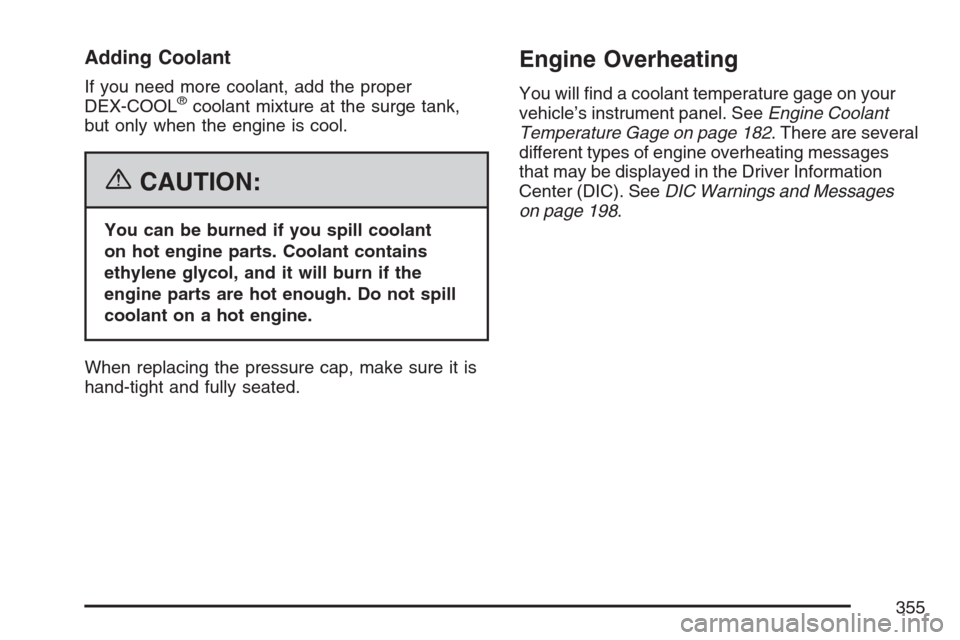
Adding Coolant
If you need more coolant, add the proper
DEX-COOL®coolant mixture at the surge tank,
but only when the engine is cool.
{CAUTION:
You can be burned if you spill coolant
on hot engine parts. Coolant contains
ethylene glycol, and it will burn if the
engine parts are hot enough. Do not spill
coolant on a hot engine.
When replacing the pressure cap, make sure it is
hand-tight and fully seated.
Engine Overheating
You will �nd a coolant temperature gage on your
vehicle’s instrument panel. SeeEngine Coolant
Temperature Gage on page 182. There are several
different types of engine overheating messages
that may be displayed in the Driver Information
Center (DIC). SeeDIC Warnings and Messages
on page 198.
355
Page 393 of 492

When a low tire pressure condition is detected,
the TPMS will illuminate the low tire pressure
warning symbol on the instrument panel cluster,
and at the same time a message to check
the pressure in a speci�c tire will appear on the
Driver Information Center (DIC) display. The
low tire pressure warning symbol on the instrument
panel cluster and the check tire pressure
message will appear at each ignition cycle until
the tires are in�ated to the correct in�ation
pressure. Using the DIC, tire pressure levels can
be viewed by the driver. For additional information
and details about the DIC operation and displays
seeDIC Operation and Displays on page 193
andDIC Warnings and Messages on page 198.
The low tire pressure warning light may come on
in cool weather when the vehicle is �rst started,
and then turn off as you start to drive. This may be
an early indicator that the air pressure in the
tire(s) are getting low and need to be in�ated to
the proper pressure.
A Tire and Loading Information Label, attached to
your vehicle, shows the size of your vehicle’s
original equipment tires and the correct in�ationpressure for your vehicle’s tires when they are cold.
SeeLoading Your Vehicle on page 315, for an
example of the Tire and Loading Information
Label and its location on your vehicle. Also see
In�ation - Tire Pressure on page 390.
Your vehicle’s TPMS system can warn you about a
low tire pressure condition but it does not replace
normal tire maintenance. SeeTire Inspection and
Rotation on page 396andTires on page 382.
Notice:Do not use a tire sealant if your vehicle
has Tire Pressure Monitors. The liquid sealant
can damage the tire pressure monitor sensors.
The TPMS will not function properly if one or more
of the TPMS sensors are missing or inoperable. If
the system detects a missing or inoperable sensor,
an error message SERVICE TIRE MONITOR
SYSTEM will be shown on the DIC display. If you
have replaced a tire/wheel assembly without
transferring the TPMS sensors, the error message
will be displayed. Once you re-install the TPMS
sensors, the error message should go off. See your
dealer for service if all TPMS sensors are installed
and the error message comes on and stays on.
393
Page 421 of 492

Instrument Panel, Vinyl, and Other
Plastic Surfaces
A soft cloth dampened with water may be used to
remove dust. If a more thorough cleaning is
necessary, a clean soft cloth dampened with a
mild soap solution can be used to gently remove
dust and dirt. Never use spot lifters or removers
on plastic surfaces. Many commercial cleaners and
coatings that are sold to preserve and protect
soft plastic surfaces may permanently change the
appearance and feel of your interior and are
not recommended. Do not use silicone or
wax-based products, or those containing organic
solvents to clean your vehicle’s interior because
they can alter the appearance by increasing
the gloss in a non-uniform manner.
Some commercial products may increase gloss on
your instrument panel. The increase in gloss
may cause annoying re�ections in the windshield
and even make it difficult to see through the
windshield under certain conditions.
Care of Safety Belts
Keep belts clean and dry.
{CAUTION:
Do not bleach or dye safety belts. If you
do, it may severely weaken them. In a
crash, they might not be able to provide
adequate protection. Clean safety belts
only with mild soap and lukewarm water.
Weatherstrips
Silicone grease on weatherstrips will make them
last longer, seal better, and not stick or squeak.
Apply silicone grease with a clean cloth. During
very cold, damp weather frequent application may
be required. SeeRecommended Fluids and
Lubricants on page 448.
421
Page 427 of 492
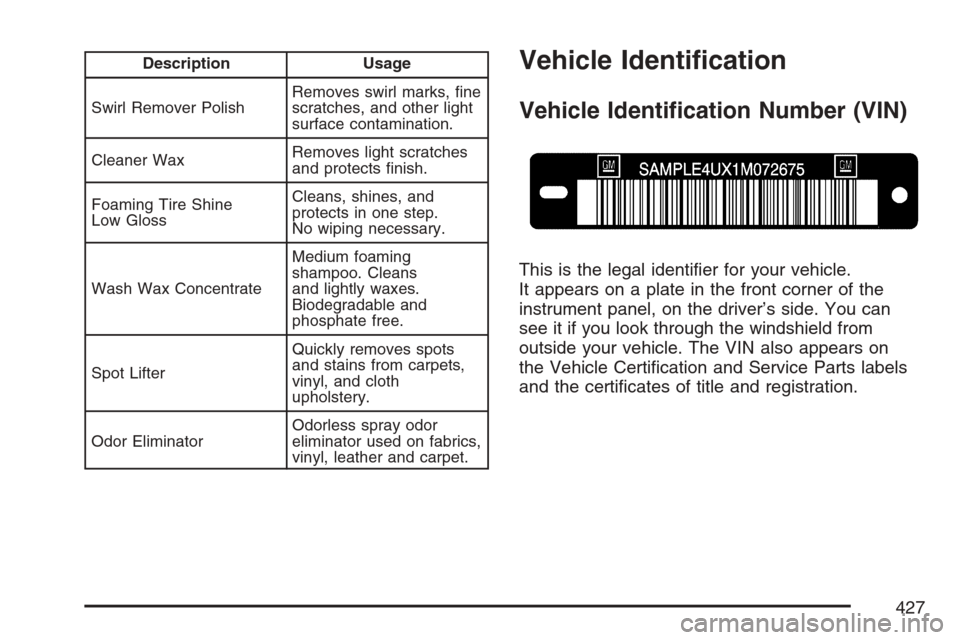
Description Usage
Swirl Remover PolishRemoves swirl marks, �ne
scratches, and other light
surface contamination.
Cleaner WaxRemoves light scratches
and protects �nish.
Foaming Tire Shine
Low GlossCleans, shines, and
protects in one step.
No wiping necessary.
Wash Wax ConcentrateMedium foaming
shampoo. Cleans
and lightly waxes.
Biodegradable and
phosphate free.
Spot LifterQuickly removes spots
and stains from carpets,
vinyl, and cloth
upholstery.
Odor EliminatorOdorless spray odor
eliminator used on fabrics,
vinyl, leather and carpet.Vehicle Identi�cation
Vehicle Identi�cation Number (VIN)
This is the legal identi�er for your vehicle.
It appears on a plate in the front corner of the
instrument panel, on the driver’s side. You can
see it if you look through the windshield from
outside your vehicle. The VIN also appears on
the Vehicle Certi�cation and Service Parts labels
and the certi�cates of title and registration.
427
Page 429 of 492
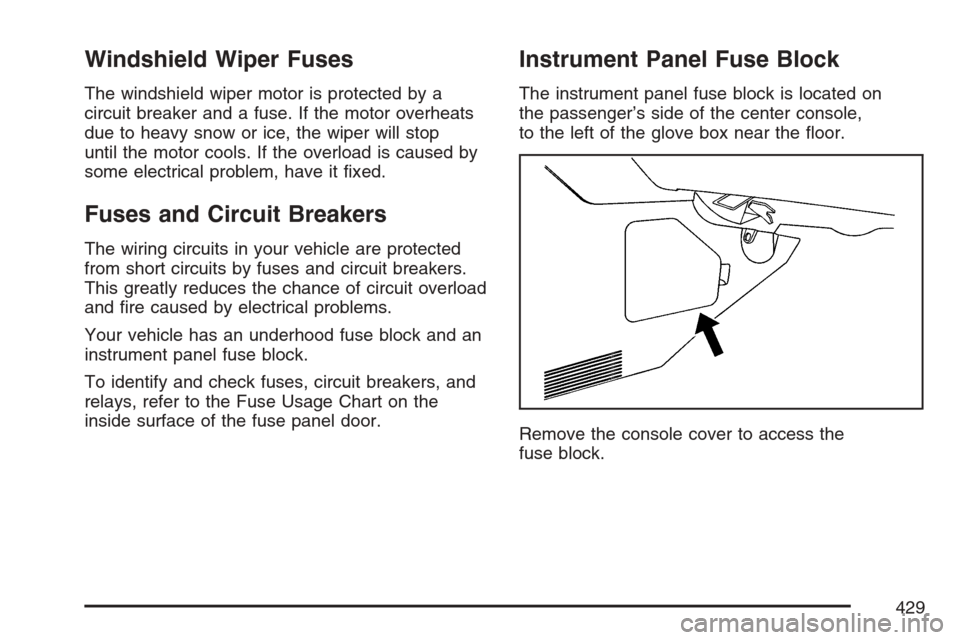
Windshield Wiper Fuses
The windshield wiper motor is protected by a
circuit breaker and a fuse. If the motor overheats
due to heavy snow or ice, the wiper will stop
until the motor cools. If the overload is caused by
some electrical problem, have it �xed.
Fuses and Circuit Breakers
The wiring circuits in your vehicle are protected
from short circuits by fuses and circuit breakers.
This greatly reduces the chance of circuit overload
and �re caused by electrical problems.
Your vehicle has an underhood fuse block and an
instrument panel fuse block.
To identify and check fuses, circuit breakers, and
relays, refer to the Fuse Usage Chart on the
inside surface of the fuse panel door.
Instrument Panel Fuse Block
The instrument panel fuse block is located on
the passenger’s side of the center console,
to the left of the glove box near the �oor.
Remove the console cover to access the
fuse block.
429
Page 456 of 492
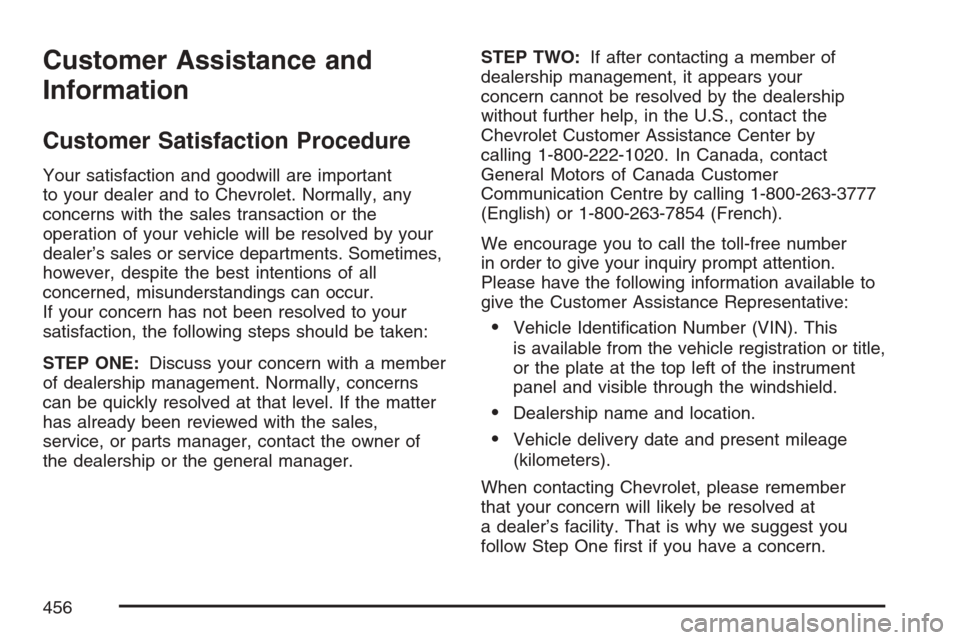
Customer Assistance and
Information
Customer Satisfaction Procedure
Your satisfaction and goodwill are important
to your dealer and to Chevrolet. Normally, any
concerns with the sales transaction or the
operation of your vehicle will be resolved by your
dealer’s sales or service departments. Sometimes,
however, despite the best intentions of all
concerned, misunderstandings can occur.
If your concern has not been resolved to your
satisfaction, the following steps should be taken:
STEP ONE:Discuss your concern with a member
of dealership management. Normally, concerns
can be quickly resolved at that level. If the matter
has already been reviewed with the sales,
service, or parts manager, contact the owner of
the dealership or the general manager.STEP TWO:If after contacting a member of
dealership management, it appears your
concern cannot be resolved by the dealership
without further help, in the U.S., contact the
Chevrolet Customer Assistance Center by
calling 1-800-222-1020. In Canada, contact
General Motors of Canada Customer
Communication Centre by calling 1-800-263-3777
(English) or 1-800-263-7854 (French).
We encourage you to call the toll-free number
in order to give your inquiry prompt attention.
Please have the following information available to
give the Customer Assistance Representative:
Vehicle Identi�cation Number (VIN). This
is available from the vehicle registration or title,
or the plate at the top left of the instrument
panel and visible through the windshield.
Dealership name and location.
Vehicle delivery date and present mileage
(kilometers).
When contacting Chevrolet, please remember
that your concern will likely be resolved at
a dealer’s facility. That is why we suggest you
follow Step One �rst if you have a concern.
456
Page 477 of 492
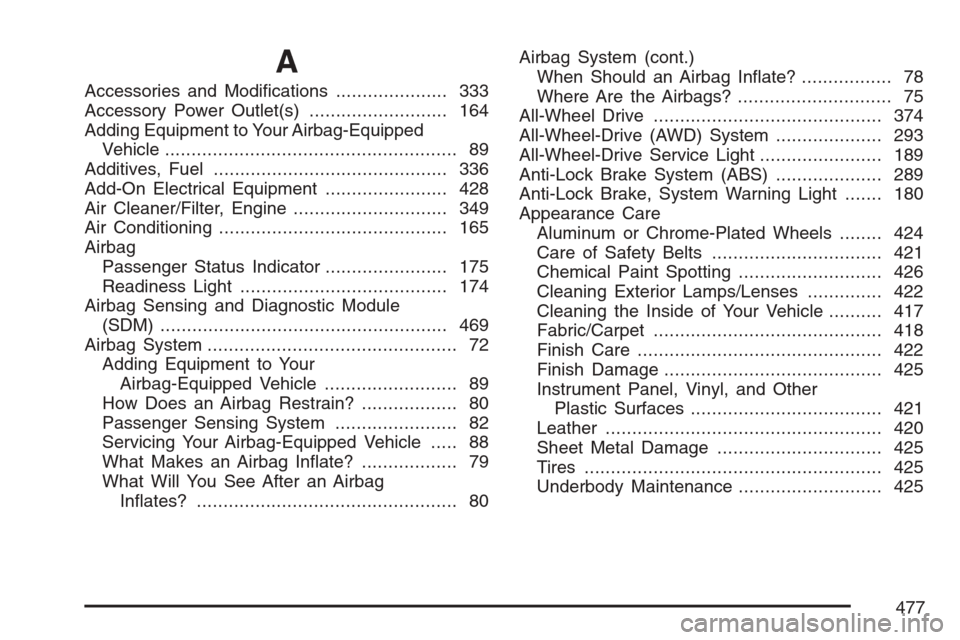
A
Accessories and Modi�cations..................... 333
Accessory Power Outlet(s).......................... 164
Adding Equipment to Your Airbag-Equipped
Vehicle....................................................... 89
Additives, Fuel............................................ 336
Add-On Electrical Equipment....................... 428
Air Cleaner/Filter, Engine............................. 349
Air Conditioning........................................... 165
Airbag
Passenger Status Indicator....................... 175
Readiness Light....................................... 174
Airbag Sensing and Diagnostic Module
(SDM)...................................................... 469
Airbag System............................................... 72
Adding Equipment to Your
Airbag-Equipped Vehicle......................... 89
How Does an Airbag Restrain?.................. 80
Passenger Sensing System....................... 82
Servicing Your Airbag-Equipped Vehicle..... 88
What Makes an Airbag In�ate?.................. 79
What Will You See After an Airbag
In�ates?................................................. 80Airbag System (cont.)
When Should an Airbag In�ate?................. 78
Where Are the Airbags?............................. 75
All-Wheel Drive........................................... 374
All-Wheel-Drive (AWD) System.................... 293
All-Wheel-Drive Service Light....................... 189
Anti-Lock Brake System (ABS).................... 289
Anti-Lock Brake, System Warning Light....... 180
Appearance Care
Aluminum or Chrome-Plated Wheels........ 424
Care of Safety Belts................................ 421
Chemical Paint Spotting........................... 426
Cleaning Exterior Lamps/Lenses.............. 422
Cleaning the Inside of Your Vehicle.......... 417
Fabric/Carpet........................................... 418
Finish Care.............................................. 422
Finish Damage......................................... 425
Instrument Panel, Vinyl, and Other
Plastic Surfaces.................................... 421
Leather.................................................... 420
Sheet Metal Damage............................... 425
Tires........................................................ 425
Underbody Maintenance........................... 425
477